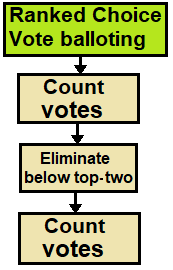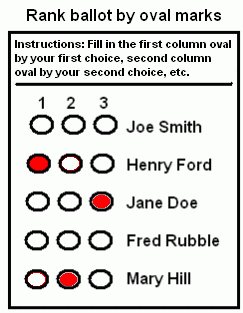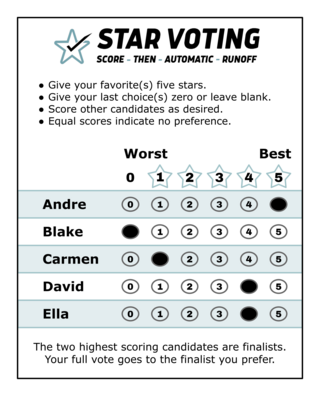Plurality voting refers to electoral systems in which a candidate who polls more than any other is elected. In systems based on single-member districts, it elects just one member per district and may also be referred to as first-past-the-post (FPTP), single-member plurality (SMP/SMDP), single-choice voting, simple plurality or relative majority. A system that elects multiple winners elected at once with the plurality rule and where each voter casts multiple X votes in a multi-seat district is referred to as plurality block voting. A semi-proportional system that elects multiple winners elected at once with the plurality rule and where each voter casts just one vote in a multi-seat district is known as single non-transferable voting.

The two-round system (TRS), also known as runoff voting, second ballot, or ballotage, is a voting method used to elect a single candidate, where voters cast a single vote for their preferred candidate. It generally ensures a majoritarian result, not a simple-plurality result as under first past the post. Under the two-round election system, the election process usually proceeds to a second round only if in the first round no candidate received a simple majority of votes cast, or some other lower prescribed percentage. Under the two-round system, usually only the two candidates who received the most votes in the first round, or only those candidates who received above a prescribed proportion of the votes, are candidates in the second round. Other candidates are excluded from the second round.

A Condorcet method is an election method that elects the candidate who wins a majority of the vote in every head-to-head election against each of the other candidates, that is, a candidate preferred by more voters than any others, whenever there is such a candidate. A candidate with this property, the pairwise champion or beats-all winner, is formally called the Condorcet winner. The head-to-head elections need not be done separately; a voter's choice within any given pair can be determined from the ranking.

In the comparison of electoral systems, the monotonicity criterion says that ranking a candidate higher on some ballots should not cause them to lose. Douglas Woodall called the criterion mono-raise to distinguish it from participation.
Ranked pairs or the Tideman method is an electoral system developed in 1987 by Nicolaus Tideman that selects a single winner using votes that express preferences. The ranked-pairs procedure can also be used to create a sorted list of winners.
An electoral system satisfies the Condorcet winner criterion if it always chooses the Condorcet winner when one exists. The candidate who wins a majority of the vote in every head-to-head election against each of the other candidates – that is, a candidate preferred by more voters than any others – is the Condorcet winner, although Condorcet winners do not exist in all cases. It is sometimes simply referred to as the "Condorcet criterion", though it is very different from the "Condorcet loser criterion". Any voting method conforming to the Condorcet winner criterion is known as a Condorcet method. The Condorcet winner is the person who would win a two-candidate election against each of the other candidates in a plurality vote. For a set of candidates, the Condorcet winner is always the same regardless of the voting system in question, and can be discovered by using pairwise counting on voters' ranked preferences.
The Borda count electoral system can be combined with an instant-runoff procedure to create hybrid election methods that are called Nanson method and Baldwin method. Both methods are designed to satisfy the Condorcet criterion, and allow for incomplete ballots and equal rankings.
In single-winner voting system theory, the Condorcet loser criterion (CLC) is a measure for differentiating voting systems. It implies the majority loser criterion but does not imply the Condorcet winner criterion.
Anti-plurality voting describes an electoral system in which each voter votes against a single candidate, and the candidate with the fewest votes against wins. Anti-plurality voting is an example of a positional voting method.
Reversal symmetry is a voting system criterion which requires that if candidate A is the unique winner, and each voter's individual preferences are inverted, then A must not be elected. Methods that satisfy reversal symmetry include Borda count, ranked pairs, Kemeny-Young method, and Schulze method. Methods that fail include Bucklin voting, instant-runoff voting and Condorcet methods that fail the Condorcet loser criterion such as Minimax.
The exhaustive ballot is a voting system used to elect a single winner. Under the exhaustive ballot the elector casts a single vote for their chosen candidate. However, if no candidate is supported by an overall majority of votes then the candidate with the fewest votes is eliminated and a further round of voting occurs. This process is repeated for as many rounds as necessary until one candidate has a majority.

The contingent vote is an electoral system used to elect a single representative in which a candidate requires a majority of votes to win. A variation of instant-runoff voting (IRV), it is form of preferential voting. The voter ranks the candidates in order of preference, and when the votes are counted, the first preference votes only are counted. If no candidate has a majority of the votes cast, then all but the two leading candidates are eliminated and the votes received by the eliminated candidates are distributed among the two remaining candidates according to voters' preferences. This ensures that one candidate achieves a majority and is declared elected.
The later-no-harm criterion is a voting system criterion first formulated by Douglas Woodall. Woodall defined the criterion by saying that "[a]dding a later preference to a ballot should not harm any candidate already listed." For example, a ranked voting method in which a voter adding a 3rd preference could reduce the likelihood of their 1st preference being selected, fails later-no-harm.
Instant-runoff voting (IRV) or preferential voting is an electoral system that uses ranked voting. Its purpose is to elect the candidate in single-member districts with majority support even when there are more than two candidates. Instant-runoff voting most often accomplishes majority rule but does not guarantee it. It is a single-winner version of single transferable voting. Formerly the term "instant-runoff voting" was used for what many people now call contingent voting or supplementary vote.

The 2009 Burlington mayoral election was held in March 2009 for the city of Burlington, Vermont. A few years earlier, the city had switched to holding mayoral elections every three years, so this was the second mayoral election since the city's 2005 change to instant-runoff voting (IRV). In the 2009 election, incumbent Burlington mayor won reelection as a member of the Vermont Progressive Party.

An electoral system or voting system is a set of rules that determine how elections and referendums are conducted and how their results are determined. Electoral systems are used in politics to elect governments, while non-political elections may take place in business, non-profit organisations and informal organisations. These rules govern all aspects of the voting process: when elections occur, who is allowed to vote, who can stand as a candidate, how ballots are marked and cast, how the ballots are counted, how votes translate into the election outcome, limits on campaign spending, and other factors that can affect the result. Political electoral systems are defined by constitutions and electoral laws, are typically conducted by election commissions, and can use multiple types of elections for different offices.

The term ranked voting, also known as preferential voting or ranked choice voting, pertains to any voting system where voters use a rank to order candidates or options—in a sequence from first, second, third, and onwards—on their ballots. Ranked voting systems vary based on the ballot marking process, how preferences are tabulated and counted, the number of seats available for election, and whether voters are allowed to rank candidates equally. An electoral system that utilizes ranked voting employs one of numerous counting methods to determine the winning candidate or candidates. Additionally, in some ranked voting systems, officials mandate voters to rank a specific number of candidates, sometimes all; while in others, voters may rank as many candidates as they desire.
The later-no-help criterion is a voting system criterion formulated by Douglas Woodall. The criterion is satisfied if, in any election, a voter giving an additional ranking or positive rating to a less-preferred candidate can not cause a more-preferred candidate to win. Voting systems that fail the later-no-help criterion are vulnerable to the tactical voting strategy called mischief voting, which can deny victory to a sincere Condorcet winner.

STAR voting is an electoral system for single-seat elections. Variations also exist for multi-winner and proportional representation elections. The name stands for "Score then Automatic Runoff", referring to the fact that this system is a combination of score voting, to pick two finalists with the highest total scores, followed by an "automatic runoff" in which the finalist who is preferred on more ballots wins. It is a type of cardinal voting electoral system.
Tideman's Alternative Methods, including Alternative Smith and Alternative Schwartz, are two electoral systems developed by Nicolaus Tideman which select a single winner using votes that express preferences. These methods can also create a sorted list of winners.









